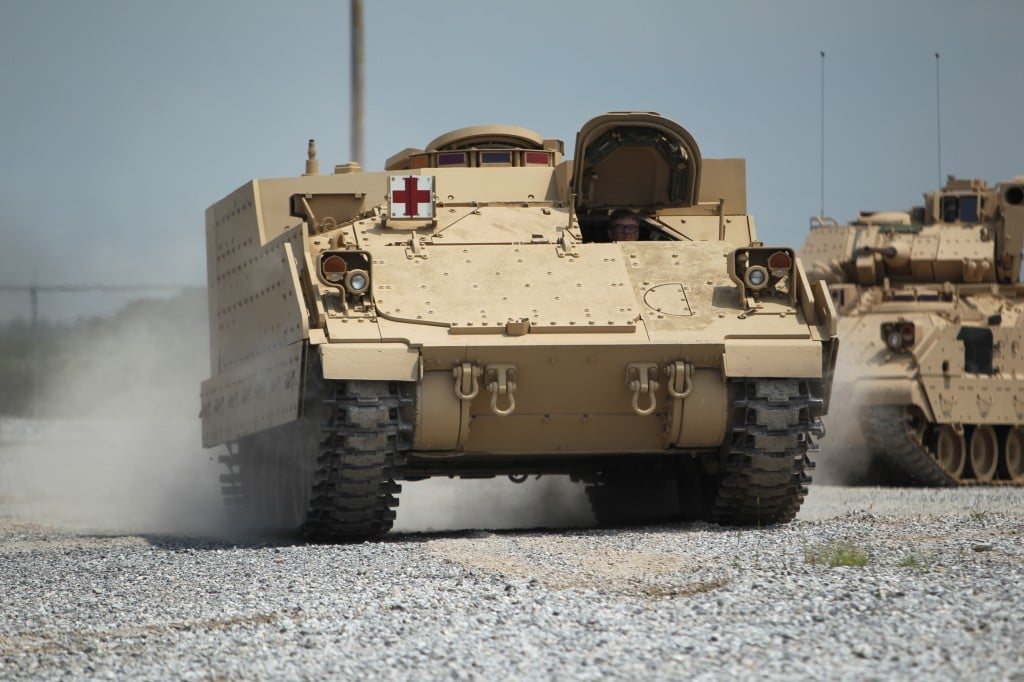The $2.6B Overrun That Never Was: A DC Cautionary Tale
Posted on

A BAE Systems prototype of the Armored Multi-Purpose Vehicle (AMPV) ambulance variant.
WASHINGTON: This morning, Sen. Dick Durbin set off heart attacks across the Army when he said the service’s $13.8 billion Armored Multi-Purpose Vehicle program was a whopping $2.6 billion over budget. AMPV is the last survivor of 14 years of cancelled major programs and deliberately designed to be modest, achievable, and affordable, so the previously unheard-of overrun shocked everyone at the hearing. Reporters and Army officials scrambled as the Army Chief of Staff, Gen. Mark Milley, promised to look into the problem.

Sen. Dick Durbin
Except, well, there wasn’t one. The entire contretemps traces to a single passage in an October report by the normally authoritative Congressional Research Service, which in turn cited a single news article from our colleagues at Inside Defense, which had, unfortunately, compared fiscal apples and oranges. The article, run February 17th, was corrected the next day — but CRS apparently missed that.
The $2.6 billion overrun? Never existed. AMPV is on budget and, if anything, a little under.
So as far as the Army leadership and its procurement is concerned, this is a non-story. As far as Washington is concerned, however, it’s a cautionary tale. One overworked staffer — and they’re all overworked — can pick a false statistic, feed it to his or her boss, and create all sorts of uproar.
The good news here is how quickly the mistake was caught. There are other unfounded figures that get repeated so long they became conventional wisdom, like the infamous $600 hammer. My favorite is the oft-cited figure that 80 percent (or 85, or 90) of the nation’s “critical infrastructure” is in the hands of private companies, not government. While this sounds reasonable, I’ve been hearing it since before the current Department of Homeland Security was created and never seen an actual source.
 In this case, Inside Defense caught its mistake quickly, but apparently CRS specialist Andrew Feickert missed the correction. The image shows part of reporter Jason Sherman’s explanation, delivered today at the speed of Twitter. (I’ve got great respect for both Feickert and Sherman, by the way. To err is human; to correct divine — but painful).
In this case, Inside Defense caught its mistake quickly, but apparently CRS specialist Andrew Feickert missed the correction. The image shows part of reporter Jason Sherman’s explanation, delivered today at the speed of Twitter. (I’ve got great respect for both Feickert and Sherman, by the way. To err is human; to correct divine — but painful).
In essence, the old article compared the Army’s estimate for the AMPV program with one from the Government Accountability Office (GAO) and described the $2.6 billion difference between the two different organizations using two different methodologies as a cost increase, rather than a difference of opinion. Inside Defense ran a correction the next day, and it’s that updated story that’s cited in the CRS report’s footnote — but the figures in the text are from the uncorrected version.
This error found its way into Durbin’s quiver of questions for this morning’s defense appropriations hearing. Acting Army Secretary Patrick Murphy said he’d have to take the question for the record, being brand new. But Gen. Milley — a take-charge kinda guy — was so eager to be responsive to the senator’s concern that he seemed to agree it was a real issue, rather than someone’s year-old math mistake:

Gen. Mark Milley
“Now we hear that your AMPV program is going to have — I don’t know if it’s a cost overrun — but an additional charge of $2.6 billion,” Sen. Durbin said. “What was the reason for this cost growth of $2.6 billion in the AMPV program?”
“I became aware of that cost overrun,” Gen. Milley replied. “I’m going to head out there and take a look at this whole thing, and I’ll report back to you [as part of] my increased role in acquisition” under last year’s defense reforms.
Well, Milley can report back quickly: That $2.6 billion overrun doesn’t exist.
Subscribe to our newsletter
Promotions, new products and sales. Directly to your inbox.
